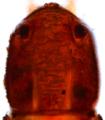Trachythrips astutus
Recognition data
Distinguishing features
Both sexes wingless. Head, pronotum, fore legs and mesonotum brown, mid and hind legs and abdomen paler, tube yellow with apical black band; antennae mainly yellow, shading to light brown at apex. Head longer than wide, cheeks convex, anterior margin projecting slightly in front of eyes, with no prominent setae, dorsal surface with irregular transverse sculpture, postocular setae not distinguished; compound eyes small, reduced to about 8 ommatidia; maxillary stylets retracted to eyes, about one third of head width apart medially. Antennae long, 5-segmented; segment III large (due to fusion of three morphological segments), V slender and constricted at base. Pronotum with no prominent setae; prosternal basantra transverse but slender. Fore tarsi with prominent hooked hamus on external margin. Meso and metanotum fused, transverse with small setae on reticulate-tuberculate sculpture. Abdominal tergite I apparently fused to tergite II; abdominal tergite IX longer than wide; tube as long as IX with long anal setae.
Male similar to female but smaller.
Related and similar species
The genus Trachythrips includes 11 species, six from the Neotropics, two from Florida, two from Texas, and one from California. However, the differences between these wingless species are not great (Mound & Marullo, 1996), and some of them may represent no more than local populations.
Taxonomic data
Current valid name
Trachythrips astutus Cott
Original name and synonyms
- Trachythrips astutus Cott, 1956: 196
Family placement
Phlaeothripidae, Phlaeothripinae
Biological data
Life history
Breeding in leaf litter.
Host plants
Fungus-feeding on fallen dead leaves of Quercus.
Tospoviruses vectored
None
Crop damage
None
Distribution data
Area of origin
Western USA.
Distribution
California, Galapagos Islands (Hoddle & Mound, 2011).





